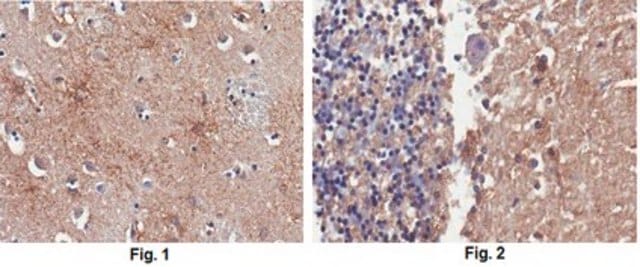MAB1596
Anti-Post Synaptic Density Protein 95 Antibody, clone 6G6-1C9
clone 6G6-1C9, Chemicon®, from mouse
Sinônimo(s):
PSD-95
About This Item
Produtos recomendados
fonte biológica
mouse
Nível de qualidade
forma do anticorpo
purified immunoglobulin
tipo de produto de anticorpo
primary antibodies
clone
6G6-1C9, monoclonal
reatividade de espécies
mouse, rat, bovine
fabricante/nome comercial
Chemicon®
técnica(s)
immunocytochemistry: suitable
immunohistochemistry: suitable
western blot: suitable
Isotipo
IgG2a
nº de adesão NCBI
nº de adesão UniProt
Condições de expedição
dry ice
modificação pós-traducional do alvo
unmodified
Informações sobre genes
bovine ... Dlg4(100137840)
mouse ... Dlg4(13385)
rat ... Dlg4(29495)
Descrição geral
Especificidade
Imunogênio
Aplicação
Representative image from a previous lot.
Confocal fluorescent analysis of PC12 using MAb1596 Mouse mAB (Red). Actin filaments have been labeled with Alexa Fluor 488 -Phalloidin (Green). Nuclear is stained with DAPI (Blue). Membrane staining positive.
Immunocytochemistry:
12.5 µg/mL
Western Blot:
1-5 μg/mL (ECL) on rat brain lysate (20 μg).
Optimal working dilutions must be determined by the end user.
Neuroscience
Synapse & Synaptic Biology
Qualidade
Descrição-alvo
Ligação
forma física
Armazenamento e estabilidade
Handling Recommendations: Upon first thaw, and prior to removing the cap, centrifuge the vial and gently mix the solution. Aliquot into microcentrifuge tubes and store at -20°C. Avoid repeated freeze/thaw cycles, which may damage IgG and affect product performance. Note: Variabillity in freezer temperatures below -20°C may cause glycerol containing solutions to become frozen during storage.
Nota de análise
Mouse brain, rat brain tissue.
Outras notas
Informações legais
Exoneração de responsabilidade
Not finding the right product?
Try our Ferramenta de seleção de produtos.
recomendado
Código de classe de armazenamento
10 - Combustible liquids
Classe de risco de água (WGK)
WGK 2
Certificados de análise (COA)
Busque Certificados de análise (COA) digitando o Número do Lote do produto. Os números de lote e remessa podem ser encontrados no rótulo de um produto após a palavra “Lot” ou “Batch”.
Já possui este produto?
Encontre a documentação dos produtos que você adquiriu recentemente na biblioteca de documentos.
Nossa equipe de cientistas tem experiência em todas as áreas de pesquisa, incluindo Life Sciences, ciência de materiais, síntese química, cromatografia, química analítica e muitas outras.
Entre em contato com a assistência técnica








